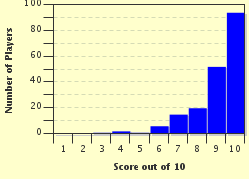Quiz Answer Key and Fun Facts
1. Two superpowers engaged in no large-scale battles 1947-1991, though they were tightly entwined in war. The United States and which other giant were at "cold war"?
2. During the Cold War the US and Soviet Union each had allies, the Western and Eastern Blocs. A third bloc included Sweden, Austria and Cambodia. What was that block called? (Don't ask me, I'm staying out of it).
3. In 1946 Winston Churchill gave a famous speech in which he called for an alliance against the Soviets, his recent WWII allies. What did Churchill accuse the Soviets of establishing?
4. In 1946 the Soviets produced the Novikov telegram. In it they declared that the US wanted nothing less than which of these? (Lex Luthor wanted this, too)
5. Not all war was "cold" during the Cold War. Which country was involved in a "hot" war, meaning warfare combat, in the 1950s?
6. About 1955 the US, Canada, Greenland and Iceland agreed to the construction of a chain of manned radar stations across the Arctic at roughly the 69th parallel. What was this line called?
7. In 1957 owing to the mutual need for early warning and ready response should a threat occur from the Soviet Union, Canada and the USA established a joint military group. What was its acronym?
8. During the Cold War the US and the Soviets were in competition for more than travel in space. They vied for position in athletics, music, espionage, chess, movie-making, psychological research, and education.
9. The foreign policy of presidents Nixon and Ford favored a "thawing out" or relaxing of the tense resentments between the US and the Soviet Union. What was this important if temporary period of warm up called?
10. MAD, or Mutually Assured Destruction, was the Cold War concept that rancor and mistrust between the US and Soviet Union could very quickly escalate into what threat to the entire planet?
Source: Author
Godwit
This quiz was reviewed by FunTrivia editor
bloomsby before going online.
Any errors found in FunTrivia content are routinely corrected through our feedback system.

